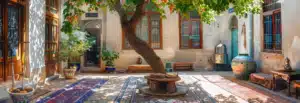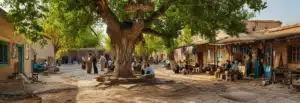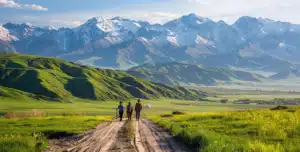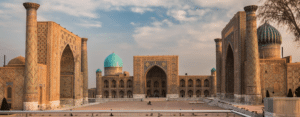We often think of Uzbekistan as a static fresco, frozen in the splendour of the domes of Samarkand, the backstreets of Bukhara and the golden palaces of Khiva. Yet behind these postcard images, there is another Uzbekistan: one with vibrant young people, a thriving arts scene, a reinvented gastronomy and a magnificent natural environment where you can still venture far from the crowds. Sarbon Tour invites you to discover an unexpected Uzbekistan, between heritage and modernity, preserved traditions and bold innovations. Far from the usual itineraries, this journey plunges you into the daily lives of the craftsmen, chefs, artists and entrepreneurs who are shaping the country today. From the urban frescoes of Tashkent to the delicate weavings of the Fergana valley, from the revisited flavours of trendy restaurants to the starry nights under a yurt, come and meet a vibrant and surprising Uzbekistan.
Beyond the mosaics: the contemporary face of a mythical country
Far from being just an open-air museum, today's Uzbekistan vibrates to the rhythm of a youth eager to create and innovate. In Tashkent, a capital undergoing constant change, the streets are adorned with daring street art, trendy cafés are shaking up codes and local start-ups are shaping the future of a country in full effervescence.
Street art: when Tashkent becomes a living canvas
If the domes of Samarkand tell the story of the caravaneers on the Silk Road, the walls of Tashkent tell the story of Uzbekistan today. In neighbourhoods like Eski Shahar, frescoes by young local artists transform facades into colourful works that blend history, culture and futuristic visions. Urban art festivals, such as the Tashkent Street Art Festival, attract artists from all over the world every year, establishing the city as a modern creative crossroads.

Trendy cafés and start-ups: the effervescence of a connected generation
At the heart of this cultural renaissance are a growing number of cafés and coworking spaces, providing fertile ground for young entrepreneurs and artists. Places like Breadly Café and Black Bear Kofi offer top-quality coffee, while Choyxona #1 revisits the concept of traditional tea houses in a contemporary setting. In the world of local start-ups, innovation is king. Whether it's Booketplace, a platform revolutionising the distribution of books in Uzbek, or young fashion brands fusing ancient textiles with modern designs, Uzbekistan is reinventing itself without denying its past.
Immersive culinary experience: Uzbek flavours revisited
When you think of Uzbek cuisine, images of steaming plov, plump mantis and crispy samsas immediately spring to mind. But while these emblematic dishes continue to delight gourmets, a new generation of chefs is daring to shake up tradition, revisiting these classics with a touch of modernity and daring.

Gastronomy revisited: when plov gets a new twist
Usually served on a large ceramic plate, plov, the king of Uzbek tables, is now available in lighter, more refined versions. In Tashkent, restaurants such as SalSal and Afsona are reinterpreting this ancestral dish with unexpected ingredients: quinoa, foie gras, or a vegan version with pumpkin and cashew nuts. Yes, plov can be trendy, and we promise that it will retain its comforting flavour!
From traditional choyxonas to new gourmet restaurants
In the past, the choyxona - the tea house where friends shared a meal - was the place to be for Uzbeks. Today, these historic institutions rub shoulders with more contemporary addresses, where ancestral recipes are rediscovered from an innovative angle. Mantis ravioli, usually served with just a touch of vinegar, are now enhanced by yoghurt sauces infused with wild herbs. Samsas, small turnovers filled with meat or squash, come in gourmet versions, stuffed with local goat's cheese and caramelised figs.
Craft drinks and new trends
When it comes to drinks, Uzbekistan is no longer content with traditional green tea served in porcelain cups. Young baristas dare to innovate: saffron and rose infusions, cardamom and almond milk lattes, or cocktails made with local vodka infused with spices from the Chorsu market. Wine lovers will also be surprised: the vineyards of the Samarkand valley are gaining in reputation, producing vintages with aromas of dried fruit and spices, perfect to accompany a plate of artisanal cheeses.
Living legacies: craftsmen, masters of the ancestral gesture
Uzbekistan may be a land of history, but it is also a land of craftsmen where skills are passed on with meticulous care and passion. Behind every embroidered fabric, every sheet of calligraphic paper and every finely painted ceramic, there are expert hands perpetuating traditions that began centuries ago. These craftsmen are the heirs of the merchants and designers who once made the Silk Road famous, and whose works were prized by emperors, scholars and explorers from the four corners of the globe. Even today, these crafts continue to exist, carried on by masters who refuse to see their precious heritage disappear.
Samarkand paper: know-how handed down from the Silk Road
In Samarkand, the tradition of making mulberry paper dates back to the 8th century, when Chinese craftsmen captured in battle against the Arabs were forced to reveal their technique. This exceptionally fine paper soon replaced parchment as one of the most prized materials for calligraphers and intellectuals in Central Asia. Today, this art is preserved in workshops such as the one in Meros, where the ancestral process is still followed.
The mulberry wood is first harvested, then soaked in water to soften the fibres. These are then crushed using heavy wooden mallets before being transformed into a fine paste. This is spread out on sieves, dried in the sun and polished with a jade stone to give it its smooth, silky texture. This paper, once used for scientific and religious manuscripts, is now used to reproduce illuminations, make art notebooks and even restore old documents. Watching a craftsman at work, with his measured gestures and infinite patience, is like stepping back in time and touching Uzbekistan's intellectual history at first hand.

Weaving and embroidery in the Fergana Valley: an exceptional textile art form
In the Fergana Valley, silk weaving and embroidery are traditions deeply rooted in the daily lives of the local people. In Marguilan, the cradle of Uzbek silk, weavers perpetuate the art of ikat, a technique that involves dyeing the threads before weaving them. This complex process creates fuzzy, vibrant patterns that seem to dance on the surface of the fabric. In a traditional workshop, you can watch the craftsmen knot each thread, immerse them in natural dye baths and line them up on a wooden loom. Each fabric takes weeks to weave into a dress, scarf or decorative item that combines tradition and modernity.
A few kilometres from Marguilan, the embroiderers of Rishton and Bukhara delicately fashion the famous Suzanis, embroidered hangings with floral and symbolic motifs. In the past, every young girl made her suzani as a dowry, inserting symbols of prosperity and happiness. Today, these textile works of art still adorn the walls of homes and are sought after the world over for their refinement. In a small family workshop, an embroiderer proudly explains the meaning of the motifs she weaves with infinite patience: each flower, each arabesque tells a story, a wish for the future, a link with the land and the ancestors.
Unexpected ecotourism: Uzbekistan's out-of-town adventures
Far from the historic cities and bustling markets, Uzbekistan offers unspoilt nature and unique experiences, from mountain hikes to nights under the stars. This immense territory, made up of endless steppes, lush green valleys and deep blue lakes, is an invitation to adventure and to discover a nomadic way of life that has endured for centuries. With horses galloping over rocky ridges and campfires crackling under the starry sky, exploring the wilds of Uzbekistan is a total immersion in the soul of the country.

Hiking and horse-riding in the Nourata mountains
Located to the east of the Kyzylkoum desert, the Nourata mountains are an ideal destination for lovers of nature and wide open spaces. This mountain range, with its steep slopes and deep valleys, is home to little-travelled trails offering breathtaking panoramas. On a hike, you'll cross gorges where river water has carved out spectacular rock formations, before reaching high plateaux where meadows carpeted with wild flowers stretch out. Along the way, you will come across villages where the inhabitants still live a pastoral lifestyle, cultivating their land and herding goats and horses.
As horse riding is an age-old tradition in Uzbekistan, it is also possible to explore the region on horseback, as the caravaneers of the Silk Road once did. Riding a sturdy, hardy Uzbek steppe horse gives you access to steep paths and allows you to appreciate the raw beauty of the landscape. After several hours' riding, a well-deserved break is in order at a mountain tea house, where you can enjoy hot bread from a clay oven, accompanied by fresh cheese and local honey.
Nights in a yurt on the shores of Lake Aydarkul: an immersion in nomadic culture
A few hours' drive from the Nourata mountains, Lake Aydarkoul is an unexpected oasis in the middle of the arid steppes. This expanse of freshwater, formed accidentally after the Syr Darya river was diverted, has become a refuge for many species of migratory birds and a favourite place to live for nomadic herders. Spending a night in a yurt camp on the shores of the lake is a unique experience, providing an insight into the daily lives of the shepherds who perpetuate an ancestral way of life. At sunset, travellers are invited to share a dinner under the tent, featuring local specialities such as shurpa, a mutton soup flavoured with spices, and bread baked in the tandoor. Once night has fallen, far from any light pollution, the sky is transformed into a breathtaking spectacle where the Milky Way can be seen with unequalled clarity.
In the morning, after a traditional breakfast, you can explore the shores of the lake, watch the birds flying over the water in search of fish, or take a camel ride in the surrounding dunes. This holiday offers a return to basics, an immersion in a world where time passes differently, to the rhythm of nature and nomadic traditions. With Sarbon TourDiscovering Uzbekistan also means moving away from traditional itineraries to enjoy unique experiences, from exceptional crafts to wilderness adventures. Every encounter, every landscape and every night under the stars reveals an unknown and fascinating facet of this bewitching country.
The hidden faces of mythical cities
When you think of Uzbekistan, you immediately imagine the turquoise domes of Samarkand, the majestic medersas of Bukhara and the ancient ramparts of Khiva. These cities, once essential stages on the Silk Road, continue to fascinate travellers with their rich heritage. But behind these emblematic sites, another world exists: that of forgotten alleyways, small family mosques hidden behind carved wooden doors and confidential cultural events that bring local traditions back to life. For those who like to get off the beaten track and discover the true soul of a place, Sarbon Tour opens the door to an intimate and secret Uzbekistan.
The narrow streets of Bukhara and Khiva: a journey into the past away from the main squares
If you let yourself be guided by the wide tourist avenues, Bukhara and Khiva appear to be museum cities where every building seems frozen in time. But all you have to do is venture into the discreet alleyways, step away from the large caravanserais and push open a wooden door with the patina of centuries to discover an authentic and vibrant world.
In Bukhara, the narrow labyrinthine streets hide unsuspected treasures. Behind an ordinary brick wall is a family mosque, a modest place of prayer with a peaceful, intimate atmosphere. These small mosques, often run by families for several generations, retain a sincere spirituality, far removed from the crowds that invade the Kalyan medersa.
In Khiva, exploring the courtyards of the city's old houses is a real immersion in the daily life of the inhabitants. Some of the houses, still inhabited by families of craftsmen, feature period wall paintings, richly decorated ceilings and flower-filled patios where tea is still served as it was in days gone by. It is even possible to gain access to secret rooftops offering a breathtaking view of the city, where blue domes and slender minarets stand out against the golden evening sky.

Tashkent and Samarkand: the vibrant culture of Uzbekistan on the move
Tashkent, often overshadowed by its historical counterparts, is nonetheless a city full of surprises. Far from the imposing Soviet buildings, it is home to little-known districts where contemporary art and culture are reinvented. The district of Eski Shahar, the old town, is a fascinating mix of traditional houses, craftsmen's workshops and cultural cafés where artists and intellectuals meet. This is where you'll find some of the best street markets, where you can sample grilled kebabs, pumpkin-filled samsas and cardamom-scented pastries while listening to musicians improvise a dutar melody.
In Samarkand, behind landmark monuments such as the Registan and Tamerlane's mausoleum, small cultural festivals bring local traditions back to life. Depending on the season, you can attend Sufi music concerts in an old medersa, a crafts exhibition in a restored caravanserai or a traditional dance performance in an open-air teahouse. These events, which are often overlooked on traditional tourist routes, offer a different way of experiencing Samarkand, by immersing yourself in its cultural and artistic effervescence.
Travelling differently: a bridge between tradition and modernity
Uzbekistan is a land of contrasts, where the legacies of the past and the dynamics of the present intertwine to form a country in the throes of change. Behind the majestic facades of the medersas and the thousand-year-old silk roads, another journey is possible: one that takes us to meet a craftsman in his workshop, a chef boldly reinventing the plov or a nomadic horseman sharing his stories under a starry yurt. It is this intimate, lively and resolutely forward-looking Uzbekistan that Sarbon Tour invites you to discover. By choosing to explore the hidden faces of mythical cities, to immerse yourself in traditional crafts, to taste cuisine undergoing a renaissance and to set off on an adventure through awe-inspiring landscapes, travel becomes a richer, more human and more memorable experience. Whether you're a history buff, a culture buff or an adventurer at heart, Uzbekistan has surprises in store at every bend in the road, every encounter and every sunrise over its endless steppes.
Sarbon Tour specialises in tailor-made trips to Uzbekistan.
They offer authentic and immersive itineraries to discover the country from a unique angle. Whether you want to explore mythical cities, meet local craftsmen, taste local flavours or venture off the beaten track, Sarbon Tour designs experiences to suit your desires. For more information and to plan your trip: 🌐 Sarbon Tour







